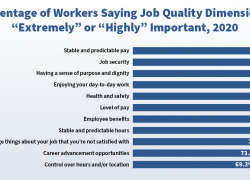
Good, family sustaining jobs make our economy and our nation stronger, but our current structure of work is not enough to provide families with economic security.
That’s why the Department of Labor is committed to better measuring and understanding what makes a good job, and working with governments, employers, and workers to make that vision a reality. In 2022, the Department announced a partnership with the Job Quality Measurement Initiative, a network of academic researchers, workforce experts, and philanthropy, organized by the Families and Workers Fund. This initiative sought to help us understand how we can work together to better measure, analyze, and report job quality data by better understanding the existing landscape of job quality measures as well as exploring potential sources of new measurement of job quality information.
This collaboration builds on the continuing work of the Good Jobs Initiative at the Department of Labor, which, along with the Department of Commerce, has released a framework of eight Good Jobs Principles which explain what constitutes a good job. The framework helps inform how federal investments could drive toward equitable and quality job-making.
How to Measure Job Quality
Working with over a hundred experts both in and out of government, the Job Quality Measurement Initiative released a report documenting ten big ideas to better measure job quality.
-
Measure what matters to workers
-
Workers care about more than just salaries. Benefits, schedules, safety, and career pathways are all key components of a good job.
-
Center equity
-
To understand disparities in job quality, we must disaggregate data to show who is not being served by our current institutions.
-
Increase mandatory human capital disclosure
-
Companies that invest in their workers perform better, and publicizing this data will push markets to reward companies that create good jobs.
- Link public and private data to gain new insights into the quality of jobs
-
Though there does not yet exist a systematic way of bringing together job quality data from private companies and different government agencies, building collaborations will better serve workers.
-
Leverage business data to demonstrate the return on investment from good jobs
-
Building the case for good jobs will require demonstrating that there is a competitive advantage for firms that take the high road.
-
Revise data systems to include non-W2 workforce
-
Current systems do not adequality measure non-W2 workers, and better understanding this workforce will help us better meet their needs
-
Strengthen workforce system metrics
-
Revise workforce system metrics from outputs, such as placement, to outcomes, such as achieving a living wage, will help us better meet our goal of a more equitable economy.
-
Use public and private spending to measure and strengthen equity and good jobs
- Aligning government procurement and spending with our shared goals to improve job quality will increase our ability to scale and make an impact
-
Strengthen state and local capacity of data-driven decision making
-
Helping our partners improve their data capacity is the first step to generating more data-driven decisions
As Acting Secretary Su explains, “With good measurement tools, we can focus not only on more jobs, but on good jobs. And when we have a better understanding of job quality, we can ensure we have an equitable economy.” This report provides concrete, actionable recommendations for working across government and sectors to build an economy that works for everyone.
The Department of Labor will work to implement these recommendations and has already taken several steps in that direction:
First, the Department is entering into data-sharing agreements with states to better understand equity in the Unemployment Insurance program, and to measure more accurately who is served and who is not.
Second, the Good Jobs Initiative will build on these recommendations in their soon-to-be-released Toolkit, providing resources on how to embed strong job quality policies and measure Good Jobs funded by federal dollars.
Third, the Department of Labor is participating in the Equity in Federal Funding Interagency Working Group, which will conduct rapid equity assessments to inform program design and delivery of federal funding.
Finally, the JQMI will continue to do important work, including measuring workers' voices and creating a scorecard to measure if employers are succeeding in creating good jobs.

 U.S. Department of Labor Blog
U.S. Department of Labor Blog

